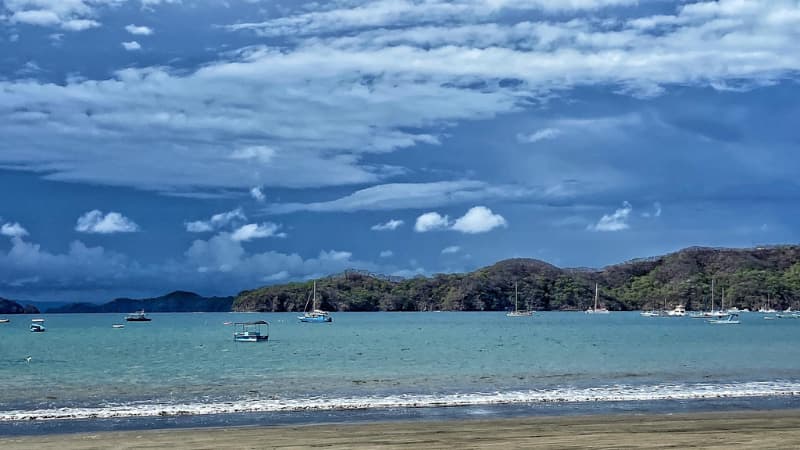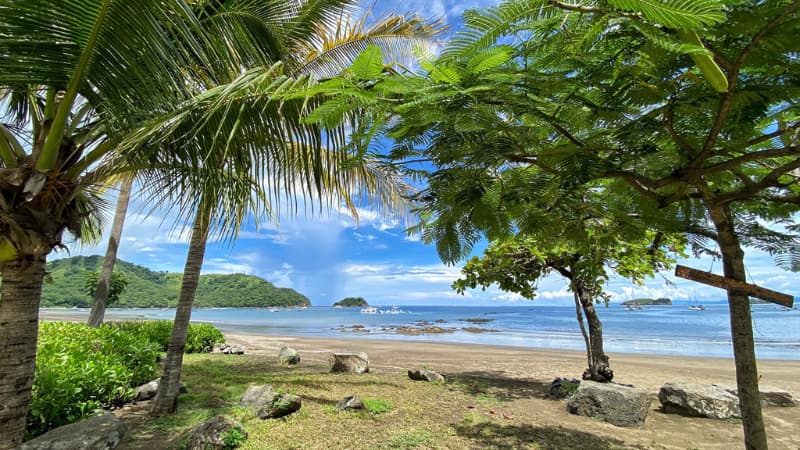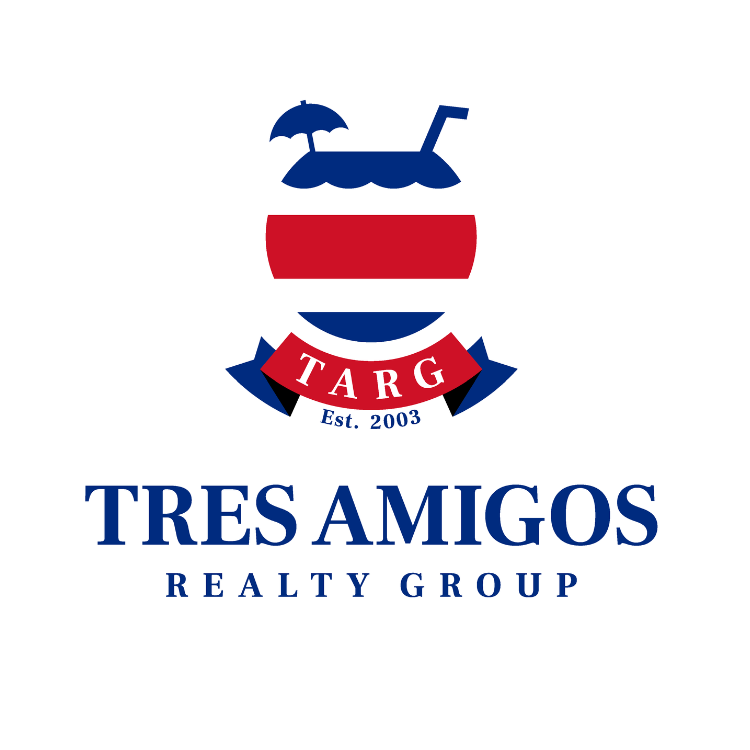Playas del Coco is an expat hotspot located in what has become known as Guanacaste's Gold Coast
The Gulfo de Papagayo (“Rooster Gulf”) and the Polo Turístico [“Tourist Destination (Project)”]
The Gold Coast includes the Peninsula Papagayo, anchored at its tip by The Four Seasons Resort at Peninsula Papagayo, Costa Rica. The Peninsula faces the open Pacific Ocean to the west, and the gorgeous, deep-water, horseshoe-shaped bay of Bahía Culebra (“Snake Bay”) to the east and south. Bahia Culebra ends at Punta Ballena (“Whale Point”), which separates Playa Panamá from Playa Hermosa.
This specific region of the Gold Coast is called the Polo Turístico – an independent entity, of sorts, that is controlled and administrated by the Instituto Costarricense de Turismo (Costa Rica Tourism Institute), a.k.a. the “ICT”.
Other big money, well-known international brands like Planet Hollywood, Hilton, Barceló, One & Only, Ritz-Carlton, Waldorf Astoria, Andáz, Hyatt, Sirenis, and Mariott all have a presence here on the Polo Turístico that circles Bahía Culebra in the Gulf of Papagayo.
This is an area that was targeted for big money, 5-star, all-inclusive style tourism development in 1970. Its story begins decades ago, when land around the Polo Turístico was purchased – re-appropriated, actually – and deemed “concession” land by the ICT. Though plans began in 1970 but didn’t really get off the ground until 1991. The first resort to be constructed in the Polo Turístico (The Four Seasons Resort at Peninsula Papagayo) only opened in 2004. Nothing happens overnight here in Costa Rica!
Due south of Punta Ballena, which anchors the southern end of the Polo Turistico, you’ll find the expat hotspots of Playa Hermosa, Playas del Coco, and Playa Ocotal. These communities are NOT part of the Polo Turístico and do not fall under the ICT’s jurisdiction (though one might argue that Playa Hermosa is in kind of a grey area – complicated). However, property in these communities located in the Zona Marítimo Terrestre (“Maritime Land Zone” or “ZMT”) does fall under the ICT’s, as well as the Municipalidad de Carrillo’s (“Municipality of Carrillo), jurisdiction.
Sidebar: The ZMT is the area of beachfront property that lies 200 meters from the high-tide line. The first 50 meters from the high tide line is called the Zona Publica (“Public Zone”). The next 150 meters is called the Zona Restringida (“Restricted Zone”) and is commonly referred to as “concession” property. 95%+ of the ZMT in Costa Rica is concession property – in other words, it is not fee simple, titled property – and falls under the rules and regulations for development, as defined by the ICT. Foreign expats may not own rights to a concession outright. At least 50% of the concession must belong to either a Costa Rican national or a Permanent Resident and is contingent upon adherence to the ICT’s development rules and requirements. If you don’t adhere to the ICT’s rules and regs, you risk the concession being ruled invalid and losing your rights to it.
“El Coco” – From sleepy fishing village to boom town.
 Evidence of people living in Playas del Coco dates back to 540 A.D. Bones and artifacts discovered in 2014 in a nearby cemetery show, via carbon dating, that the region was in use from about 540 A.D. to 885 A.D. But it wasn’t until the 1930’s, when Hector Zuñiga Rovira wrote the song entitled Amor de Temporada [“(The) Love of the Season”], that the town was put on the map and became a destination for national tourists. In a tale as old as time, the song is about a tourist who falls in love with a local morena (“dark-skinned woman”), only to have his heart broken by vacation’s end.
Evidence of people living in Playas del Coco dates back to 540 A.D. Bones and artifacts discovered in 2014 in a nearby cemetery show, via carbon dating, that the region was in use from about 540 A.D. to 885 A.D. But it wasn’t until the 1930’s, when Hector Zuñiga Rovira wrote the song entitled Amor de Temporada [“(The) Love of the Season”], that the town was put on the map and became a destination for national tourists. In a tale as old as time, the song is about a tourist who falls in love with a local morena (“dark-skinned woman”), only to have his heart broken by vacation’s end.
Back in the day – and in Costa Rica, “the day” was mere decades ago – El Coco was remote and difficult to reach. By 1956, there were still only about 4 families totaling less than 100 people living there, sharing a single well for drinking water. There was no electricity, no paved roads, and only one bus made its way there, to and from Liberia each day.
In the 1960s, the roads in Guanacaste and leading to El Coco began to improve. Cabinas (“beach cabins”) were built and national tourism began to grow. By the late 1980s, El Coco had been “discovered” by international tourists, and by the 1990s the boom was on. And, with one of only two of Costa Rica’s international airports – Aeropuerto Internacional Daniel Oduber Quirós [“Daniel Oduber Quirós International Airport” (LIR) a.k.a. Guanacaste Aeropuerto, “Guanacaste Airport”] – within 25 minutes’ reach, it hasn’t stopped booming.
El Coco went through some pretty serious growing pains in the mid-2000s. In 1977, the above-mentioned ZMT law was passed, prohibiting construction on the beach in the Public Zone. The majority of homes and businesses in old El Coco were constructed in the Public Zone, forcing residents to move their homes and businesses elsewhere.
Most residents did not comply. It wasn’t until 2007 that the law was enforced, and the government came in and demolished everything still standing in the Public Zone. It was a significant amount of construction and in many peoples’ minds, the heart and soul of El Coco.
In place of the old structures, the Municipality built a public beachfront park and named it Paseo de Amor de Temporada [“Promenade of the (The) Love of the Season”], after the old 1930’s song that originally put El Coco on the map for national tourists.
The Boom!
Today, Playas del Coco is a vibrant, bustling, beach/party-town filled with a mix of locals, retired expats, expat families, and national and international tourists. The latter group’s population spikes dramatically during Costa Rican holidays and the high tourism season that runs from November through May. But somehow El Coco still manages to retain its former fishing village roots: Fishing boats remain anchored in the azure waters just off its dark-sand, crescent-shaped beach… although these days, there are more yachts and pleasure craft out there alongside them.
Big development exploded around 2002-03 when Grupo Mapache began developing hundreds of modern condominium units in and around Playas del Coco, the most notable concentration of which were built in what is called the Las Palmas area. They were very reasonably priced in the $40,000 to $50,000 range. North American retirees began buying them up by the handful.
With the affordable housing boom and the sudden influx of cash, came land-use violations, contract violations, fraud, and Municipal corruption – especially with respect to obtaining water and building permits. The legacy of this period has been litigation and indictments, some of which persist to this day.
The big development landscape changed in 2006-07 when the Jack Parker Corporation from the US launched sales on its high-end development called Pacifico. Up to that point, big development in El Coco had been relatively low-end and mostly generic. The time was ripe for some high-end, exclusive, residential development. Home lots and condos in Pacifico resonated with wealthy national and foreign investors alike, and Jack Parker Corp. hit this one out of the ballpark.
Today, both Las Palmas and Pacifico are expat strongholds in El Coco. Each is at the opposite end of the development and economic spectrum. And their aesthetics and residential populations reflect that fact.
In spite of all of the explosive development, changes, and growing pains (past and current), the general city fabric of El Coco – especially its “Main Street” – is fairly cohesive and, some might say, even charming – in a funky, tropical, beachy, and very El Coco kind of way.
“El Coco Loco”
 In a mostly sleepy province, El Coco is famous for its nightlife. It’s a party town! Hence, it’s nickname, El Coco Loco (“Crazy Coco”).
In a mostly sleepy province, El Coco is famous for its nightlife. It’s a party town! Hence, it’s nickname, El Coco Loco (“Crazy Coco”).
The main street of Playas del Coco bustles by day with bicycles, shoppers, delivery vehicles, and golf carts, and by night grows crowded with party-seekers of all ages, patrolling on foot in search of drink specials and live entertainment. It’s tough to find a parking spot during the high season. And you can forget New Year’s Eve – it’s shoulder to shoulder!
Amenities:
Downtown El Coco offers just about any amenity you’ll ever want: hardware and home stores, banks and ATMs, supermarkets and bars, a wide variety of shopping and dining options; live entertainment, public and private clinics, hotels and a casino; restaurants, and private dental care offices – the works.
Bottom line: When you live in El Coco, you don’t have to drive for long distances to find what you want. It’s all right here – and one of the main reasons El Coco is so popular with older expats and, increasingly, with younger families.
If you have any major health issues, the Hospital San Rafael Arcángel, in downtown Liberia, is the only private hospital in the area. Located only about 35 minutes away, it offers 24/7 emergency services and has 55 specialists on staff. It also has state-of-the-art technology, a radiology lab, two operating rooms, a laboratory clinic, pharmacy, and modern hospitalization accommodations. AND, it offers laser cosmetic surgery – enormously popular with the older expat retirees here (wink).
For expats who have Costa Rican residency, or who are in the process of obtaining it, Liberia’s public hospital, Hospital Enrique Baltodano Briceño, provides emergency, surgical, laboratory, pharmacy services along with hospitalization that is covered by Costa Rica’s social security system, Caja Costarricence de Seguro Social (CCSS, a.k.a. “Caja”). Residents and nationals pay into the system and in return pay nothing out of pocket at hospitals and clinics with the CCSS system. It’s Medicare for all here in Costa Rica.
Broadband internet, cable TV, and mobile voice and data services are readily available. Telecable is the big cable/broadband provider here, though Liberty, Kölbi, Coopeguanaste, and Claro also offer home internet, internet TV, and mobile voice and data packages. They also offer pre-pay and post-pay cell phone service options; you can pay your monthly fees or add minutes to your account, at local supermarkets, sodas, banks, and other convenient locations. It’s super easy!
Satellite broadband is available through SkyNet, itellum, and very soon through Starlink.
Big box stores Walmart and PriceSmart (Costa Rica’s version of Costco) are located only about 30 minutes and 20 minutes away, respectively. And they offer everything that you can get in North America, and then some, because the buy locally. The Solarium business park consists of less-than-retail distributors of everything from furniture and ceramic tile to craft beer, seafood, and meats.
For those with kids, there are plenty of private, bilingual schools in or near El Coco, with reasonable tuition and enrollment fees like Dolphins Academy School (Pre-K-12), Lakeside International School (Pre-K-12), and La Paz Community School Tempisque Campus (Pre-K-12). Each offers its own curriculum style, and all costa a fraction of what North American private schools cost while offering an equal or better education for your kids.
As we stated above, Liberia’s international airport is only a 25-minute drive from downtown El Coco. All major US airlines have direct flights from their hubs. And there are a number of Latin American and European airlines that have followed suit. So, getting back home to visit your family and friends – or having them come visit you – is incredibly convenient. It’s easy getting from here to there (and back again).
Real Estate in Playas del Coco:
 El Coco has a vibrant real estate rental and sales market, which means there is plenty of real estate inventory to choose from – and enough choice to accommodate almost any budget – though it’s a seller’s market right now so be prepared.
El Coco has a vibrant real estate rental and sales market, which means there is plenty of real estate inventory to choose from – and enough choice to accommodate almost any budget – though it’s a seller’s market right now so be prepared.
That said, sales prices tend to be somewhat “all over the map.” There is no “real” MLS (“Multiple Listing Service”) in Costa Rica so it’s difficult, if not impossible, to get sales comps from a database. You’ll need an experienced, reputable real estate consultant to help you find what you’re looking for.
As a general rule for real estate rental properties:
- Studio and 1BR apartments in Las Palmas rent from about $650/month and up (figure about $1500/month for a luxury condo).*
- A nice 2BR/1BA or 2BR/2BA condo will run you from about $1,000/month and up (figure about $2,000/month for a luxury condo).*
- 3BR/2BA single-family homes rent at about $2,500/month and go up from there, depending on location, etc.*
*Condos and homes are typically fully furnished. Cable TV, internet, and electricity are sometimes included, but not usually.
As a general rule, for real estate sale properties in El Coco:
- Studio and 1BR/1BA condos are typically priced from about $70,000 and go up from there (figure about $280,000, minimum, for a fully furnished luxury condo).
- 2BR/2BA condos are typically priced from about $220,000 and go up from there (figure about $400,000 for a fully furnished luxury condo).
- 2BR/2BA single family homes start in the $300,000 range and go up from there. If you want an ocean view, add another $300,000.
- 3BR/2.5BA single family homes start in the $500,000 range and go up from there. As with above, add $300,000 if you want an ocean view.
These are extremely general guidelines that should give you a feel for the market. But remember, there’s quite a bit of inventory in El Coco, and that inventory ranges from affordable, to mid-market, to luxury ocean view properties in gated communities with amenities.
Beachfront property – or close-to-the-beach property – will mean you’ll spend more on rentals and purchases. Also, properties with amenities like swimming pools, indoor parking, commercial areas, and beach clubs will cost more.
The whole enchilada.
Guanacaste’s Playas del Coco is an expat hotspot for both retirees and families with kids because it has just about everything you’ll need to live the lifestyle you want without having to travel too far– if anywhere – to find it. It’s vibrant, fun, beautiful, well-priced, and super convenient – the whole enchilada, as we say.
If the whole enchilada sounds like your kind of lifestyle, put Playas del Coco at the top of your exploratory trip list and contact me. Let’s get the conversation started! ¡Pura vida!







